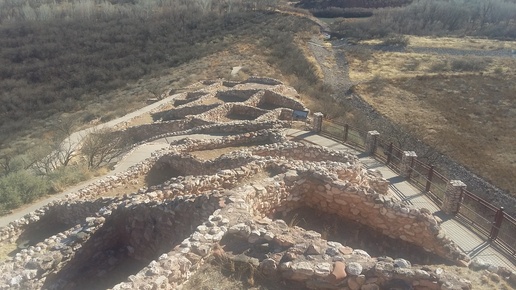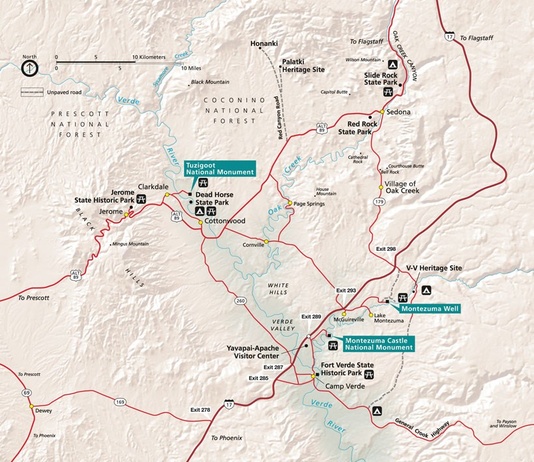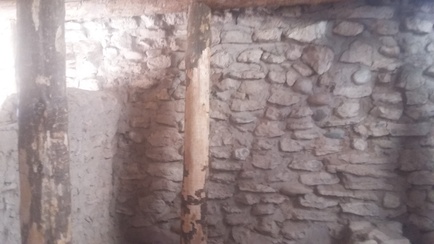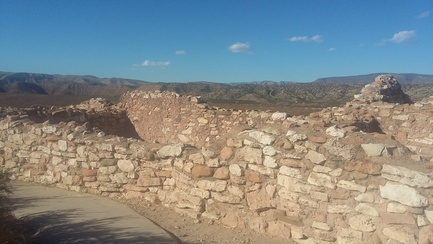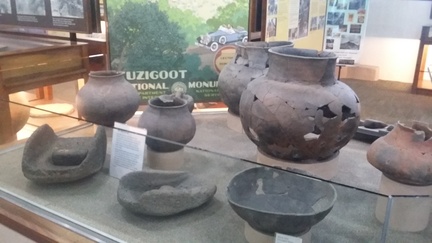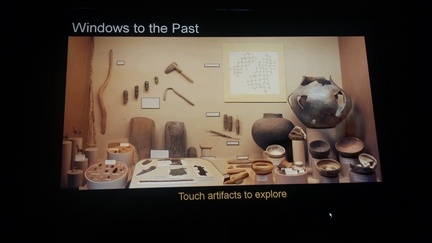The Tuzigoot National Monument, located in Clarkdale, Arizona, originally a “company town”, is a local treasure. Dating back to the 1930s, this monument was nothing but a hill of dirt and rock. An archeological committee of the Yavapai County Chamber of Commerce surveyed the area and “wanted to collect artifacts for an exposition of the prehistory of the county”. Two archeologists, also graduate students from the University of Arizona, Louis R. Caywood and Edward H. Spicer, led the excavation in 1933, giving jobs to local families in desperate need during the Great Depression. They wanted to name the site and a Tonto Apache crew member suggested Tu zighoot (TWO-see-WHOODT) which means “crooked water”. The translation has changed over time to what we know it as today, Tuzigoot (TWO-zee-goot).
This monument, known as a pueblo, was built back in the 1300s by pre-Columbian culture archeologists called the Sinagua. As more people moved to the village, the rooms would change in size, layout and functionality. It housed 110 rooms and could hold up to 250 people. The rooms were quite small measuring about 200 square feet and it is said that an entire family might have lived in one room. Even though this space was a bit tight, it was much roomier than other pueblos farther north. They used stone tools for everyday use such as a ground stone tool called basalt metate, or basalt rock. The basalt metate was used for grinding corn kernels to make corn flour. It would then be ground again on a finer-grained rock like sandstone. The pueblo was built on a hill, so the villagers could monitor their surroundings, and this also kept them away from mosquitoes and floods which would happen if living by the river.
The Sinagua constructed the pueblo by using materials at hand like large boulders for foundations, juniper logs as support posts, Cottonwood and Pine trees for roof beams, and reeds, willow branches, juniper bark, and grasses were woven together for insulation. They laid up double walls that tapered with height and filled spaces with rubble. The blocks of limestone and river stones required large amounts of mortar, accounting for more than half of a wall’s volume. The masonry was 24 to 30 inches thick.
The Sinagua were divided into two branches, the Northern and the Southern. The North Sinagua occupied the area what is now Flagstaff and the South occupied the middle of the Verde River, known now as the Verde Valley. Sometime after A.D. 1125, they survived by learning the plants, animals, climate and soil of the Verde Valley. The Southern Sinagua expanded to the Red Rocks (what is now Sedona) to raise crops and from A.D. 1150 to 1300 they “reached their maximum territorial extent, with villages of 3 to 10 families scattered throughout every environmental niche in the Verde Valley. But, between A.D. 1300 and 1400, the climate fluctuated dramatically between wet and dry periods” ("Verde Valley Archaeology Center - Early Inhabitants"). By, A.D. 1400, the Sinagua left the Verde Valley possibly due to climate change, disease, conflict, disrupted trade networks or depleted soils. However, according to the Yavapai-Apache, some of the Sinagua stayed in the area and married into the Yavapai and Apache tribes.
During excavation, the crew moved more than 5,000 cubic yards of earth and 20,000 cubic yards of masonry. After the excavation, the ruins needed some reconstruction because of erosion. The floors and walls need ongoing preservation treatments because they collapsed due to eroded mortar. In order to keep this monument standing, preservationists had to take modern protection measures and used cement for the walls, placing capstones, covering the floors with dirt and adding drains to keep the water from standing in the rooms.
The Tuzigoot museum was built after excavation in 1935 by the community to promote tourism, pay tribute to public archeology as well as display all the artifacts and history of the area that was uncovered and became part of the National Park Service in 1939. As the crew started digging, they found pieces of history, including many different types of tools and pieces of what was once large storage vessels. All the pieces of the storage vessels found were then repaired, each piece put back together like a puzzle. The repair solutions included Durham’s Rock-Hard Water Putty to fill in pieces missing. After 70 years on display, in 2006 the large storage vessels were sent to Tucson, AZ to be treated, removing unstable adhesives and unnecessary fills.
Originally the monument was 58 acres but in December 2005, the National Park Service expanded to include the spring-fed freshwater wetlands called Tavasci Marsh. It now totals 96 acres. The Marsh is the largest freshwater marsh in northern Arizona that is not associated with the Colorado river. It feeds into the Verde River and more than 245 species of birds have been seen around the marsh and the river. When visiting, you can take a self-guided tour of 1/3 mile that loops around the pueblo and through the 110 rooms. While on this trail, there are amazing views of the Verde River and Tavasci Marsh. There is also a 1/2-mile trail that leads you to a beautiful overlook of Tavasci Marsh. The museum has all of the historic artifacts on display for everyone to see and learn about the way the people lived many years ago. Today, there are still many unanswered questions about this pueblo and the people that dwelled there.
Citation:
"Verde Valley Archaeology Center - Early Inhabitants." Verde Valley Archaeology Center - Home, www.verdevalleyarchaeology.org/EarlyInhabitants. Accessed 18 Feb. 2018.
References
https://www.nps.gov/tuzi/learn/nature/wetlands-and-marshes.htm
https://www.verdevalleyarchaeology.org/Tuzigoot
https://www.nps.gov/moca/learn/news/upload/Echoes-Fall-2010-Final-Web.pdf
http://www.arizonaruins.com/tuzigoot/tuzigoot.html
http://www.americansouthwest.net/arizona/tuzigoot/national_monument.html

